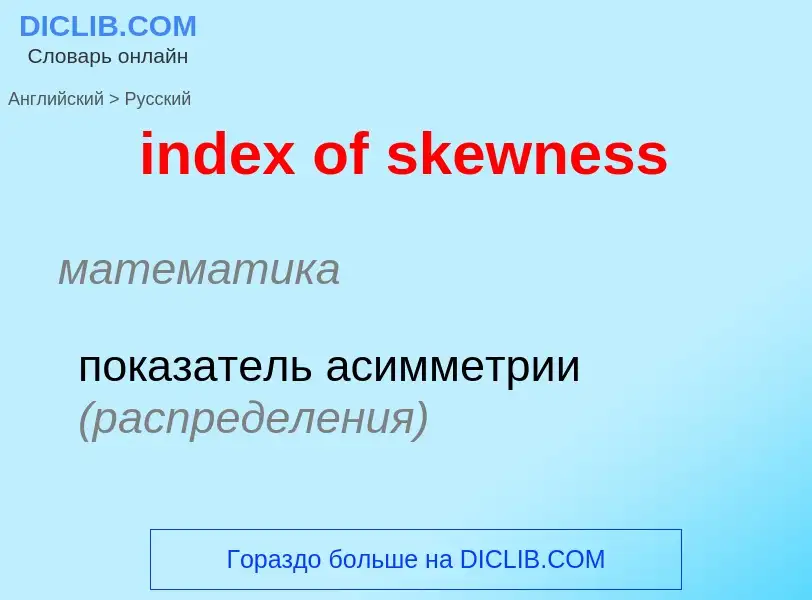Tradução e análise de palavras por inteligência artificial
Nesta página você pode obter uma análise detalhada de uma palavra ou frase, produzida usando a melhor tecnologia de inteligência artificial até o momento:
- como a palavra é usada
- frequência de uso
- é usado com mais frequência na fala oral ou escrita
- opções de tradução de palavras
- exemplos de uso (várias frases com tradução)
- etimologia
index of skewness - tradução para russo
математика
показатель асимметрии (распределения)
математика
асимметричное (несимметричное) распределение
общая лексика
асимметричное распределение
Definição
Wikipédia

In optics, the refractive index (or refraction index) of an optical medium is a dimensionless number that gives the indication of the light bending ability of that medium.
The refractive index determines how much the path of light is bent, or refracted, when entering a material. This is described by Snell's law of refraction, n1 sin θ1 = n2 sin θ2, where θ1 and θ2 are the angle of incidence and angle of refraction, respectively, of a ray crossing the interface between two media with refractive indices n1 and n2. The refractive indices also determine the amount of light that is reflected when reaching the interface, as well as the critical angle for total internal reflection, their intensity (Fresnel's equations) and Brewster's angle.
The refractive index can be seen as the factor by which the speed and the wavelength of the radiation are reduced with respect to their vacuum values: the speed of light in a medium is v = c/n, and similarly the wavelength in that medium is λ = λ0/n, where λ0 is the wavelength of that light in vacuum. This implies that vacuum has a refractive index of 1, and assumes that the frequency (f = v/λ) of the wave is not affected by the refractive index.
The refractive index may vary with wavelength. This causes white light to split into constituent colors when refracted. This is called dispersion. This effect can be observed in prisms and rainbows, and as chromatic aberration in lenses. Light propagation in absorbing materials can be described using a complex-valued refractive index. The imaginary part then handles the attenuation, while the real part accounts for refraction. For most materials the refractive index changes with wavelength by several percent across the visible spectrum. Nevertheless, refractive indices for materials are commonly reported using a single value for n, typically measured at 633 nm.
The concept of refractive index applies across the full electromagnetic spectrum, from X-rays to radio waves. It can also be applied to wave phenomena such as sound. In this case, the speed of sound is used instead of that of light, and a reference medium other than vacuum must be chosen.
For lenses (such as eye glasses), a lens made from a high refractive index material will be thinner, and hence lighter, than a conventional lens with a lower refractive index. Such lenses are generally more expensive to manufacture than conventional ones.


![[[Diamond]]s have a very high refractive index of 2.417. [[Diamond]]s have a very high refractive index of 2.417.](https://commons.wikimedia.org/wiki/Special:FilePath/Brillanten.jpg?width=200)
![A [[calcite]] crystal laid upon a paper with some letters showing [[double refraction]] A [[calcite]] crystal laid upon a paper with some letters showing [[double refraction]]](https://commons.wikimedia.org/wiki/Special:FilePath/Calcite.jpg?width=200)

![power]] of a [[magnifying glass]] is determined by the shape and refractive index of the lens. power]] of a [[magnifying glass]] is determined by the shape and refractive index of the lens.](https://commons.wikimedia.org/wiki/Special:FilePath/Lupa.na.encyklopedii.jpg?width=200)
![Birefringent materials can give rise to colors when placed between crossed polarizers. This is the basis for [[photoelasticity]]. Birefringent materials can give rise to colors when placed between crossed polarizers. This is the basis for [[photoelasticity]].](https://commons.wikimedia.org/wiki/Special:FilePath/Plastic Protractor Polarized 05375.jpg?width=200)



![The colors of a [[soap bubble]] are determined by the [[optical path length]] through the thin soap film in a phenomenon called [[thin-film interference]]. The colors of a [[soap bubble]] are determined by the [[optical path length]] through the thin soap film in a phenomenon called [[thin-film interference]].](https://commons.wikimedia.org/wiki/Special:FilePath/Soap bubble sky.jpg?width=200)
![A [[split-ring resonator]] array arranged to produce a negative index of refraction for [[microwaves]] A [[split-ring resonator]] array arranged to produce a negative index of refraction for [[microwaves]]](https://commons.wikimedia.org/wiki/Special:FilePath/Split-ring resonator array 10K sq nm.jpg?width=200)
![In [[optical mineralogy]], [[thin section]]s are used to study rocks. The method is based on the distinct refractive indices of different [[mineral]]s. In [[optical mineralogy]], [[thin section]]s are used to study rocks. The method is based on the distinct refractive indices of different [[mineral]]s.](https://commons.wikimedia.org/wiki/Special:FilePath/Thin section scan crossed polarizers Siilinjärvi R636-105.90.jpg?width=200)
![Thomas Young]] coined the term ''index of refraction''. Thomas Young]] coined the term ''index of refraction''.](https://commons.wikimedia.org/wiki/Special:FilePath/Thomas Young (scientist).jpg?width=200)
![[[Total internal reflection]] can be seen at the air-water boundary. [[Total internal reflection]] can be seen at the air-water boundary.](https://commons.wikimedia.org/wiki/Special:FilePath/Total internal reflection of Chelonia mydas.jpg?width=200)
![Light of different colors has slightly different refractive indices in water and therefore shows up at different positions in the [[rainbow]]. Light of different colors has slightly different refractive indices in water and therefore shows up at different positions in the [[rainbow]].](https://commons.wikimedia.org/wiki/Special:FilePath/WhereRainbowRises.jpg?width=200)




